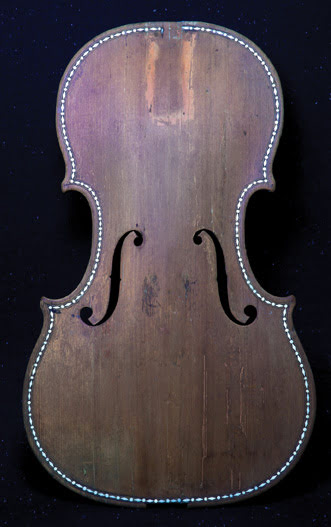
Via optics, violin plate explored
They only needed it for one day – but, of course, in the case of a rare and priceless artifact, even one day can be a lot to ask.
After the top plate of a Stradivari violin was displayed at an exhibition in Cremona, Italy, in 2011, researchers at the Università degli Studi di Pavia asked the Fondazione Stradivari for one day to study the plate’s materials before it was returned to its owner. They hoped to unlock some of the secrets of the renowned 17th-century violin master, Antonio Stradivari.
“It was a great chance for us,” said Marco Malagodi, a researcher at the Laboratorio Arvedi, which is dedicated to the study of the materials that make up historic artifacts, including stringed instruments, for applications such as replication, restoration and authenticity verification.
His team used nondestructive optics-based methods to study the varnishes and decorations on the top plate, focusing on identifying the original varnish layers and characterizing the composition of the decorations, either the inlaid purflings (three decorative strips of wood encircling the outline of the top plate) or the composite false-inlay strip between them.

A team in Italy used optical techniques to characterize the decorated top plate on a Stradivari violin. Courtesy of Marco Malagodi/Claudio Canevari.
The investigation began with UV-induced visible fluorescence, which Malagodi said provides low-level information about uniformity of the surfaces and helps identify areas for further investigation. It is useful, he said, for “first identification of some materials: e.g., proteinic glues and some natural resins.” An optical digital microscope quickly obtained morphological information about the surface.
An energy-dispersive x-ray fluorescence technique was used with micro Fourier transform IR (FTIR) spectroscopy to characterize the decoration materials and varnish residuals. They were lucky that the top plate fit onto the stage of the Nicolet iN10 Thermo Fisher micro FT-IR spectroscope, allowing them to use an attenuated total reflectance probe,
Malagodi said.
The findings included evidence of the use of black-dyed wood instead of ebony for the inlaid purflings and of the use
of shredded wood, ebony in this case, associated with ivory for the rest of the decoration. Another important finding, Malagodi noted, was evidence that the plate’s materials matched up with descriptions in “ancient books of recipes for artists and craftsmen.”
Based on analysis results, the group made a copy of the top plate and carried out on the copy the same analyses performed on the original. The research was published in Applied Physics A: Materials Science & Processing (doi: 10.1007/s00339-013-7792-2).
Published: September 2013